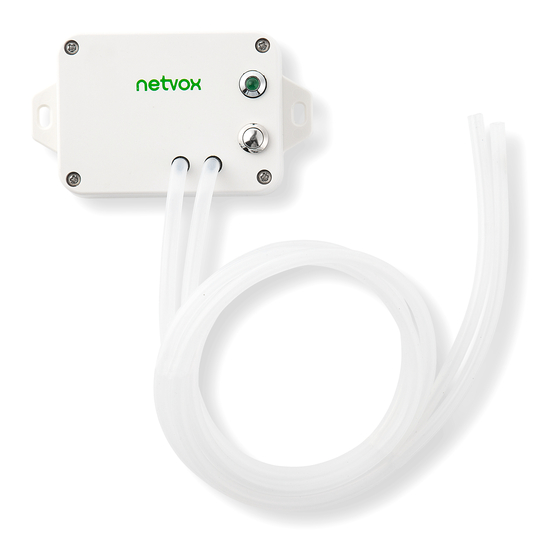
Table of Contents
Advertisement
Quick Links
Model:R718Y
Wireless Differential Pressure and Temperature
Wireless Differential Pressure
and Temperature sensor
R718Y
User Manual
Copyright©Netvox Technology Co., Ltd.
This document contains proprietary technical information which is the property of NETVOX Technology. It shall be maintained
in strict confidence and shall not be disclosed to other parties, in whole or in part, without written permission of NETVOX
Technology. The specifications are subject to change without prior notice.
Advertisement
Table of Contents

Summary of Contents for netvox R718Y
- Page 1 This document contains proprietary technical information which is the property of NETVOX Technology. It shall be maintained in strict confidence and shall not be disclosed to other parties, in whole or in part, without written permission of NETVOX Technology. The specifications are subject to change without prior notice.
-
Page 2: Table Of Contents
Table of Content 1. Introduction ............................. 3 2. Appearance ............................4 3. Main Features ..........................4 4. Set up Instruction ..........................5 5. Data Report ............................. 6 5.1 Example of ReportDataCmd ..................... 6 5.2 Example of ConfigureCmd ....................... 7 5.3 Example for MinTime/MaxTime logic ..................8 6. -
Page 3: Introduction
1. Introduction R718Y is the Class A device based on the LoRaWAN protocol of Netvox. The device detects the pressure difference and the temperature. It is compatible with the LoRaWAN protocol. LoRa Wireless Technology: LoRa is a wireless communication technology dedicated to long distance and low power consumption. Compared with other communication methods, LoRa spread spectrum modulation method greatly increases to expand the communication distance. -
Page 4: Appearance
Low power consumption and long battery life Battery Life: ⁻ Please refer to web: http://www.netvox.com.tw/electric/electric_calc.html ⁻ At this website, users can find battery life time for variety models at different configurations. 1. Actual range may vary depending on environment. -
Page 5: Set Up Instruction
4. Set up Instruction On/Off Power on Insert batteries. (The users may need a screwdriver to open.) Turn on Press and hold the function key for 3 seconds till the green indicator flashes once. Turn off (Restore to factory setting) Press and hold the function key for 5 second, and the green indicator flashes 20 times. Power off Remove Batteries. -
Page 6: Data Report
Or when the configure time is up, it will also detect and send the report with Battery, Different Pressure, and Temperature. Note: Please refer Netvox LoRaWAN Application Command document and Netvox Lora Command Resolver http://loraresolver.netvoxcloud.com:8888/page/index to resolve uplink data. -
Page 7: Example Of Configurecmd
0x01 (1byte, Unit: 0.1v) (Signed2Bytes, Unit: 0.1Pa) (Signed2Bytes,Unit:0.1°C) (3Bytes, Fixed 0x00) Uplink: 01AC0124001E0116000000 byte (01): Version byte(AC): DeviceType 0xAC - R718Y byte (01): ReportType byte (24): Battery, 24 H =36 D 36*0.1v=3.6v byte (001E): Different Pressure, 1E H =30 D 30*0.1Pa=3 Pa... -
Page 8: Example For Mintime/Maxtime Logic
81AC010000000000000000 (configuration failed) (2) Read device parameters Downlink: 02AC000000000000000000 Device returns: 82AC003C003C0100640064 (current device parameters) 5.3 Example for MinTime/MaxTime logic Example#1 based on MinTime = 1 Hour, MaxTime= 1 Hour, Reportable Change i.e. BatteryVoltageChange=0.1V MaxTime MaxTime Sleeping(MinTime) Sleeping(MinTime) Wake up and collects data Wakes up and collects data Wakes up and collects data REPORTS 3.6V... -
Page 9: Information About Battery Passivation
MinTime/MaxTime calculation is started. 6. Information about Battery Passivation Many of Netvox devices are powered by 3.6V ER14505 Li-SOCl2 (lithium-thionyl chloride) batteries that offer many advantages including low self-discharge rate and high energy density. However, primary lithium batteries like Li-SOCl2 batteries will form a passivation layer as a reaction between the lithium anode and thionyl chloride if they are in storage for a long time or if the storage temperature is too high. -
Page 10: Important Maintenance Instruction
7. Important Maintenance Instruction Kindly pay attention to the following in order to achieve the best maintenance of the product: • Keep the device dry. Rain, moisture, or any liquid might contain minerals and thus corrode electronic circuits. If the device gets wet, please dry it completely.















Need help?
Do you have a question about the R718Y and is the answer not in the manual?
Questions and answers